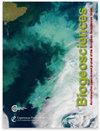Biogenic calcium carbonate as evidence for life
IF 3.9
2区 地球科学
Q1 ECOLOGY
引用次数: 1
Abstract
Abstract. The history of the Earth is a story of the co-evolution of minerals and microbes: not only have numerous rocks arisen from life but also life itself may have formed from rocks. To understand the strong association between microbes and inorganic substrates, we investigated the moonmilk, a calcium carbonate deposit of possible microbial origin, occurring in the Iron Age Etruscan necropolis of Tarquinia, in Italy. These tombs provide a unique environment where the hypogeal walls of the tombs are covered by this speleothem. To study moonmilk formation, we investigated the bacterial community in the rock in which the tombs were carved: calcarenite and hybrid sandstone. We present the first evidence that moonmilk precipitation is driven by microbes within the rocks and not only on the rock surfaces. We also describe how the moonmilk produced within the rocks contributes to rock formation and evolution. The microbial communities of the calcarenite and hybrid sandstone displayed, at the phylum level, the same microbial pattern of the moonmilk sampled from the walls of the hypogeal tombs, suggesting that the moonmilk originates from the metabolism of an endolytic bacterial community. The calcite moonmilk is the only known carbonate speleothem on Earth with undoubted biogenic origin, thus representing a robust and credible biosignature of life. Its presence in the inner parts of rocks adds to its characteristics as a biosignature.碳酸钙是生命存在的证据
摘要地球的历史就是一部矿物和微生物共同进化的故事:不仅无数的岩石起源于生命,而且生命本身也可能是由岩石形成的。为了了解微生物与无机基质之间的紧密联系,我们研究了在意大利塔奎尼亚的铁器时代伊特鲁里亚墓地中发现的一种可能是微生物起源的碳酸钙沉积物月乳。这些坟墓提供了一个独特的环境,坟墓的下壁被这些洞穴覆盖。为了研究月乳的形成,我们调查了墓葬所在岩石中的细菌群落:钙屑岩和混合砂岩。我们提出了第一个证据,证明月乳沉淀是由岩石内部的微生物驱动的,而不仅仅是岩石表面的微生物。我们还描述了岩石中产生的月乳如何有助于岩石的形成和演化。在门水平上,钙屑岩和混合砂岩的微生物群落显示出与从下葬壁取样的月乳相同的微生物模式,表明月乳起源于一种内溶细菌群落的代谢。方解石月乳是地球上唯一已知的具有无可置疑的生物起源的碳酸盐岩洞,因此代表了一个强大而可信的生命生物特征。它在岩石内部的存在增加了它作为生物特征的特征。
本文章由计算机程序翻译,如有差异,请以英文原文为准。
求助全文
约1分钟内获得全文
求助全文
来源期刊

Biogeosciences
环境科学-地球科学综合
CiteScore
8.60
自引率
8.20%
发文量
258
审稿时长
4.2 months
期刊介绍:
Biogeosciences (BG) is an international scientific journal dedicated to the publication and discussion of research articles, short communications and review papers on all aspects of the interactions between the biological, chemical and physical processes in terrestrial or extraterrestrial life with the geosphere, hydrosphere and atmosphere. The objective of the journal is to cut across the boundaries of established sciences and achieve an interdisciplinary view of these interactions. Experimental, conceptual and modelling approaches are welcome.
 求助内容:
求助内容: 应助结果提醒方式:
应助结果提醒方式:


